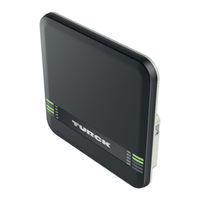turck TN-UHF LNX Series Manuals
Manuals and User Guides for turck TN-UHF LNX Series. We have 3 turck TN-UHF LNX Series manuals available for free PDF download: Instructions For Use Manual
turck TN-UHF LNX Series Instructions For Use Manual (115 pages)
UHF Reader
Brand: turck
|
Category: Microphone system
|
Size: 3 MB
Table of Contents
Advertisement
turck TN-UHF LNX Series Instructions For Use Manual (106 pages)
UHF Reader
Brand: turck
|
Category: Card Reader
|
Size: 3 MB
Table of Contents
turck TN-UHF LNX Series Instructions For Use Manual (85 pages)
UHF Read / Write Head
Table of Contents
Advertisement
Advertisement


